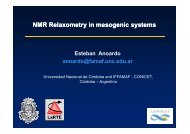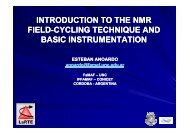Download Program and abstract book - 8th Conference on FFC ...
Download Program and abstract book - 8th Conference on FFC ...
Download Program and abstract book - 8th Conference on FFC ...
You also want an ePaper? Increase the reach of your titles
YUMPU automatically turns print PDFs into web optimized ePapers that Google loves.
Oral 26<br />
Abstract<br />
NMR relaxometry <str<strong>on</strong>g>and</str<strong>on</strong>g> translati<strong>on</strong> diffusi<strong>on</strong> in c<strong>on</strong>densed matter<br />
A. Herrmann, M. Hofmann, D. Kruk * , R. Meier, E.A. Rössler<br />
Experimentalphysik II, Universität Bayreuth, 95440 Bayreuth, Germany<br />
* permanent address: University of Warmia & Mazury in Olsztyn, Faculty of Mathematics &<br />
Computer Science, Sl<strong>on</strong>eczna 54, PL-10710 Olsztyn, Pol<str<strong>on</strong>g>and</str<strong>on</strong>g><br />
1 H <str<strong>on</strong>g>and</str<strong>on</strong>g> 19 F the relaxati<strong>on</strong> processes are predominantly caused by magnetic dipole-dipole<br />
interacti<strong>on</strong>s. For dipolar relaxati<strong>on</strong> <strong>on</strong>e distinguishes intra- <str<strong>on</strong>g>and</str<strong>on</strong>g> intermolecular relaxati<strong>on</strong><br />
pathways. While the intramolecular c<strong>on</strong>tributi<strong>on</strong> originates from interacti<strong>on</strong>s between nuclei<br />
bel<strong>on</strong>ging to <strong>on</strong>e molecule, the intramolecular relaxati<strong>on</strong> stems from interacti<strong>on</strong>s between nuclei<br />
bel<strong>on</strong>ging to different molecules or polymer segments. Thus, the intramolecular relaxati<strong>on</strong> is<br />
associated with reorientati<strong>on</strong>al dynamics, while the intermolecular part provides informati<strong>on</strong> <strong>on</strong><br />
translati<strong>on</strong>al dynamics. As the characteristic correlati<strong>on</strong> time, <br />
trans<br />
, for the translati<strong>on</strong>al<br />
dynamics is at least order of magnitude l<strong>on</strong>ger than the rotati<strong>on</strong>al correlati<strong>on</strong> time, <br />
rot<br />
, the<br />
intramolecular c<strong>on</strong>tributi<strong>on</strong> to the overall relaxati<strong>on</strong> dominates at low frequencies. Moreover, as<br />
<br />
rot<br />
trans<br />
the low frequency dispersi<strong>on</strong> of the overall relaxati<strong>on</strong> can be entirely attributed to<br />
the translati<strong>on</strong>al c<strong>on</strong>tributi<strong>on</strong>. Thus, the translati<strong>on</strong> diffusi<strong>on</strong> coefficient for diamagnetic liquids<br />
<str<strong>on</strong>g>and</str<strong>on</strong>g> polymer melts can be straightforwardly determined from the theoretically predicted 1,2 , linear<br />
dependence of the spin-lattice relaxati<strong>on</strong> rate <strong>on</strong> square root of the res<strong>on</strong>ance frequency. The<br />
obtained diffusi<strong>on</strong> coefficients agree very well with those obtained by NMR gradient<br />
diffusiometry 3 .This approach can also be applied to paramagnetic liquids (for instance c<strong>on</strong>taining<br />
nitroxide radicals) 4 . In this case <strong>on</strong>e distinguishes<br />
D [m 2 /s]<br />
10 -8 xylitol<br />
DL-threitol<br />
10 -9<br />
glycerol<br />
o-terphenyl<br />
propylene glycol<br />
10 -10<br />
2-ethyl-1-hexanol<br />
3-fluoroanilin<br />
10 -11<br />
10 -12<br />
10 -13<br />
10 -14<br />
3 4 5<br />
1000/T [K -1 ]<br />
three regi<strong>on</strong>s of linearity of the relaxati<strong>on</strong> rate<br />
versus square root of frequency. Moreover, in<br />
the case of sub-diffusive moti<strong>on</strong> in polymer<br />
systems, the mean square displacement as a<br />
functi<strong>on</strong> of time can be revealed 5,6 .<br />
Diffusi<strong>on</strong> coefficient D as obtained from FC 1H NMR (full<br />
symbols) <str<strong>on</strong>g>and</str<strong>on</strong>g> field-gradient NMR (open symbols) for<br />
several liquids versus reciprocal temperature. 3<br />
1. Y. Ayant E. Belorizky P. Fries, J. Rosset, J. Phys. (France) 1977, 38, 325<br />
2. E. Belorizky, P.H. Fries, J. Phys. C: Solid State Phys. 1981, 14, 521<br />
3. D. Kruk, R. Meier, E.A. Roessler, Phys. Rev. E 2012, 85, 020201<br />
4. D. Kruk, A. Korpała, A. Kubica, R. Meier, E. A. Rössler, J. Moscicki, J. Chem. Phys 2013 138, 024506<br />
5. M. Kehr, N Fatkullin, R. Kimmich, J. Chem. Phys. 2007, 126, 094903<br />
6. A. Herrmann, B. Kresse, J. Gmeiner, A.F. Privalov, D. Kruk, F. Fujara, E.A. Rössler, Macromolecules 2012,<br />
45; 6516–6526<br />
<str<strong>on</strong>g>8th</str<strong>on</strong>g> <str<strong>on</strong>g>C<strong>on</strong>ference</str<strong>on</strong>g> <strong>on</strong> Fast Field Cycling NMR Relaxometry, Turin 23-25 May 2013




